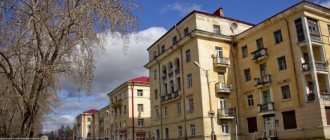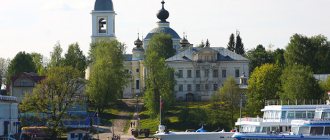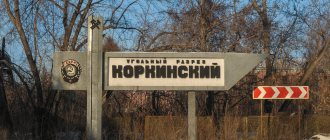Year founded: 1773
Tikhvin - City of Military Glory
Tikhvin
is a Russian city, an administrative district center in the Leningrad region, located on both banks of the Tikhvinka River (Lake Ladoga basin). The distance from the city to St. Petersburg is 236 km.
The name of the city was derived from the Tikhvin River (ancient Russian “quiet”), now it is the Tikhvinka River. Tikhvin began to be considered a city in 1773
, before that there was a Tikhvin churchyard here. Its development ensured its location at the crossroads of trade routes connecting the Volga with Ladoga and the Baltic Sea.
The city is famous for the miraculous Tikhvin Icon of the Mother of God, which, according to legend, miraculously appeared on the banks of the Tikhvinka River in 1383. Later, in 1560, by order of Tsar Ivan IV, the Mother of God Assumption Monastery was founded here, on the left bank of the Tikhvinka River. In the same year, the Tikhvin Vvedensky Convent was built. Both of these monasteries are still active today.
During the Great Patriotic War, Tikhvin was occupied by German troops. The command of Army Group North decided to strike through Tikhvin to Lodeynoye Pole, link up with Finnish troops on the Svir River and thereby completely blockade Leningrad. On November 8, 1941, the Germans captured the city, but Soviet troops managed to break the enemy. On December 9, 1941, as a result of the Tikhvin offensive operation, the city was liberated.
In 2010, Tikhvin was awarded the honorary title “City of Military Glory”.
Transfiguration Cathedral (Photo: wikipedia.org) The modern city of Tikhvin is divided into two parts: the Old Town, which is a provincial town, and the New Town - microdistricts with multi-storey buildings. The old town is mostly made of wood; in the central square there is the main temple of the city - the Transfiguration Cathedral. The new city consists of 10 residential neighborhoods.
In addition to temples, in Tikhvin you can visit the Vepsian Forest park, where you can learn about the life of the ancient people - the Vepsians, and the House-Museum of the composer Rimsky-Korsakov, a native of the city.
Tikhvin was also the birthplace of such cultural and artistic figures as director Sergei Grigoriev, painter Pyotr Zabolotsky, and Russian actor Nikolai Ivanov.
Day of the city
in Tikhvin it is celebrated in July.
Tikhvin - the city of military glory
One of the first major victories of the Soviet troops in the Great Patriotic War is associated with Tikhvin.In the very first days of the war, most men of military age left Tikhvin to join the Red Army, the People's Militia and the extermination battalion created in the city. In July, the formation of the 272nd Infantry Division began in the area of the village of Berezovik. On July 27, the fighters took the oath, during which city residents presented the Red Banner to their fellow countrymen.
On June 28, 1941, the evacuation of children from Leningrad to Tikhvin began. Numerous kindergartens for young Leningraders were additionally opened in the city.
Since September 1941, Tikhvin became a front-line city. The Tikhvin residents carried out large-scale defensive work: they dug anti-tank ditches, built pillboxes and bunkers. In August alone, 9 landing pads for aircraft were built. About a thousand people worked on construction.
Day and night, Tikhvin railway workers, despite the bombing, kept a combat watch. Instead of destroyed tracks, spare tracks were laid, on which trains with ammunition and food were formed for besieged Leningrad. The non-stop movement of the echelons was ensured even when the front line approached Tikhvin almost closely.
In October 1941, a network of eight underground Komsomol groups was formed in Tikhvin, and 6 partisan detachments were created. 18 partisans were awarded orders and medals for courage and heroism.
During the war, there were 55 medical institutions in the Tikhvin region. Tikhvin residents took a great part in their arrangement and care for the wounded.
Thousands of soldiers and officers fought near Tikhvin, 9 military personnel were awarded the title of Hero of the Soviet Union for their exploits in the battles for the city, 3 natives of the Tikhvin region were awarded this high title for their exploits on the fronts of the Great Patriotic War. 965 soldiers and commanders who fought near Tikhvin were awarded high military awards. 7 military units and formations of the Red Army were awarded the Order of the Red Banner for the Tikhvin operation.
The memory of the Great Patriotic War is immortalized in the names of 19 Tikhvin streets. 10 heroes were awarded the title “Honorary Citizen of the City of Tikhvin.”
The significance of the Battle of Tikhvin is difficult to overestimate. The fascist German command of Army Group North, trying to quickly capture Leningrad and having failed in attempts to storm it, decided to strike through Tikhvin to Lodeynoye Pole, connect with Finnish troops on the Svir River and thereby completely blockade Leningrad. For this purpose, the Nazi command concentrated in the area of Kirishi station the 39th mechanized corps, which was transferred from the west, consisting of 2 tank and 2 motorized divisions. This strike group was given the task of breaking through the small barriers of our 4th Army, capturing Tikhvin and subsequently reaching the Svir River to link up with Finnish troops.
At dawn on October 16, 1941, the Nazis went on the offensive. Despite the fierce resistance of the Soviet troops, the Nazis, thanks to their great numerical superiority, captured Tikhvin on November 8.
The fascists rejoiced: “Leningrad itself will raise its hands. He will fall sooner or later. No one will be able to break through the created lines,” Hitler said, speaking in Munich on the day of the capture of Tikhvin.
A grave threat loomed over Leningrad. The capture of Tikhvin meant the loss of the only route through which the city on the Neva was supplied with food, weapons and ammunition. And the nearest supply bases were now located 320 kilometers away, in the area of the small railway stations Zaborye and Podborovye.
The day after the fall of Tikhvin, the Headquarters of the Supreme Commander-in-Chief ordered General K. A. Meretskov to take command of the 4th Army, eliminate the enemy and provide railway communication in the Tikhvin-Budogoshch and Tikhvin-Volkhov sections.
In view of the exceptional importance of the task at hand, additional forces and resources from the Headquarters reserve were transferred to Meretskov’s disposal. Already by November 11, in certain sectors of the front, our units attacked the Germans in order to create conditions for the offensive, which was scheduled for November 19. Through stubborn battles, the Soviet troops bled the enemy dry, prevented him from reaching the Svir River and Lake Ladoga, and created the preconditions for launching a counteroffensive.
Presentation “The Hero City of Tikhvin”
Slide 1
Tikhvin
Slide 2
Coat of arms of the city of Tikhvin
Slide 3
Tikhvinsky district is one of the most remote from St. Petersburg. It is located in the northeast of the modern Leningrad region, and historically Novgorod land, on the banks of the small Tikhvinka river, which feeds Lake Ladoga. The location at the crossroads of trade routes connecting the Volga with Ladoga and the Baltic Sea ensured the rapid development of the Tikhvin Pogost, the predecessor of the city of Tikhvin. By the beginning of the 16th century it was already a well-known trade and craft center. These places received city status and the name Tikhvin in 1772.
Slide 4
The city owes its appearance to the events of 1383, when these places were first reflected in Russian chronicles. This mention is associated with the miraculous appearance of the icon of the Mother of God. The Tikhvin Icon of the Mother of God is one of the most revered Orthodox shrines in Rus'. According to legend, this image is one of those painted by the Evangelist Luke himself during the life of the Mother of God. For centuries it was preserved and revered in Byzantium, considered a symbol of the Byzantine Empire. The icon from Byzantium disappeared and some time later in 1383 miraculously appeared to fishermen on Lake Ladoga. Shining with extraordinary light, the icon walked through the air over the water. Icon of the Tikhvin Mother of God
Slide 6
On the bank of the Tikhvinka River the icon stopped. A lot of people gathered there. They immediately began construction of the temple and cut down the three crowns of the future wooden church. The next morning, when they returned to continue work, they found neither the log house, nor the harvested timber, nor the icon. The place turned out to be empty. But on the other side of the Tikhvinki River they saw the light. Coming closer to the place indicated by the light, in the swampy lowland they saw an icon, a begun frame, logs for construction and even wood chips. The icon stood on the eastern wall of the begun log house. At the place chosen by the Most Holy Theotokos for the residence of the icon, a wooden church was erected in the name of Her Dormition.
Slide 7
The construction of the first Church of the Assumption was marked by a miraculous sign - the appearance of the Mother of God and St. Nicholas to sexton George (or, as he was also called, Yurysha). George walked around the surrounding villages and informed them about the upcoming consecration of the temple. An unexpected wonderful fragrance stopped him. Before him he saw the Most Holy Theotokos in extraordinary radiance, sitting on a pine log. There was a rod in Her hand, and Nicholas the Wonderworker stood in front of Her. And the Mother of God said to him: “Go to the church and tell the priests and people not to put an iron cross on My church, but let them put a wooden one.” “Lady Lady, they won’t believe me,” said George. And I heard the words of the saint: “If they do not believe, then there will be a sign to assure them.” Returning, the sexton told about his vision, but they did not believe him, but when one of the workers climbed onto the roof of the temple with an iron cross to install it, a storm suddenly came and, as if in its arms, lifted it with the cross and placed it on the ground. This brought the priests to their senses, and a wooden cross was erected on the church.
Slide 9
The wooden Church of the Assumption burned three times. Finally, on August 12, 1515, at the behest of Grand Duke Vasily Ioannovich, a stone temple was built. And on this site the Tikhvin Great Monastery was founded.
Slide 10
Here the Tikhvin Icon of the Mother of God found her peace for several centuries and became famous as the protector of the northwestern borders of Russia. In 1611–1614, Swedish soldiers repeatedly tried to destroy the Tikhvin monastery, however, every time, the defenders repelled the enemy’s onslaught. Each victory was preceded by signs - the Tikhvin people saw that the Queen of Heaven was helping them, striking with fear the enemies who imagined countless Russian troops advancing on them from all sides.
Slide 11
In addition to this main shrine, in the Tikhvin monastery there were three more glorious icons, which were copies of the first, which were also famous for their miracles. They were called “Removable” - it was carried into the houses of local residents, “Militia” - it accompanied the Tikhvin squad during the Patriotic War of 1812, the third unique copy of the miraculous icon of the Mother of God was made on the monastery wall in memory of the first terrible test of the monastery and its miraculous deliverance from the Swedes in 1614. This icon received the popular name “On the Porch”, since it was possible to worship it only by climbing a high staircase.
Slide 12
During World War II, Tikhvin was captured by the Nazis for only a month. However, this month was enough for the complete destruction and plunder of the city. The Great Tikhvin Monastery was turned by them into a place of massacre. The Nazis stole many valuable, or rather priceless, icons, including the miraculous Tikhvin Icon of the Mother of God. In 1944, the Tikhvin miraculous icon ended up in Riga. The keeper of the icon was Archbishop of Riga John (Garklavs), who left Riga with the retreating German troops. Then the icon and its keeper came to Germany, and from there to the USA. Since 1949, the miraculous icon has been in the Trinity Cathedral in Chicago. Before his death in 1982, John bequeathed to his adopted son Sergius to return the shrine to his native monastery.
Slide 13
In the spring of 1995, the Tikhvin Mother of God Assumption Monastery, closed in 1924, was returned to the Russian Orthodox Church. In 2003, a decision was made to return the Tikhvin miraculous icon of the Mother of God to the Tikhvin Assumption Monastery for the feast day in 2004. In the summer of 2004, the icon made a farewell procession through Orthodox churches and monasteries in America, then visited Riga, she was also greeted by Moscow and St. Petersburg, and only then, after 60 years in a foreign land, she returned to the Tikhvin Monastery.
Slide 14
In the same year, 2004, the 160th anniversary of the great Russian composer Nikolai Andreevich Rimsky-Korsakov, a native of Tikhvin, was also celebrated. The Rimsky-Korsakov house stands on the banks of the Tikhvinka River, opposite the Great Monastery. Nikolai Andreevich lived in this house for the first 12 years of his life, and then, having entered the naval corps, he came to his parents on vacation for another 6 years. Now this house is the state house-museum of the great Russian composer N.A. Rimsky-Korsakov, which was opened on the 100th anniversary of the composer’s birth on July 23, 1944.
Slide 15
ON THE. Rimsky-Korsakov was born on March 6, 1844. The composer's father, Andrei Petrovich Rimsky-Korsakov, served as the Novgorod vice-governor and then as the Volyn governor. Mother - Sofya Vasilievna - the daughter of a serf peasant woman and a wealthy landowner Skaryatin, a fairly educated woman. His older brother Voin Andreevich, a rear admiral and reorganizer of the naval education system, also had a strong influence on the future composer. The composer studied piano at home and then at a boarding school. It is known that from childhood the composer was passionate about music, became acquainted with the works of Rossini, Beethoven, Meyerbeer, Mendelssohn, but the greatest impression on him was made by the music of Mikhail Glinka - his “Kamarinskaya”, “Spanish Overtures”, the operas “Ivan Susanin” and “Ruslan and Lyudmila." Nikolai Rimsky-Korsakov is the author of 15 operas (including The Snow Maiden, The Tale of Tsar Saltan, Sadko), 3 symphonies, numerous symphonic works and instrumental concerts.
Economy
Industry
See also: Tikhvin industrial site
During Soviet times, the largest employer in Tikhvin was a heavy machinery plant known as Transmash
until 2001, where tractors and defense equipment were produced. During its heyday, 20,000 people worked here. The plant was very negatively affected by the collapse of the Soviet Union and post-Soviet economic problems. Tractor production ceased in 2003, and by 2005 the workforce was down to about a thousand. The plant was acquired in 2001 by the ICT Group and reorganized, the ferroalloy plant (acquired by Mechel in 2008), and the carriage building plant - in the first decade of the 21st century.
Other industrial enterprises in the city include an IKEA furniture manufacturer, a construction company, a wood chemical plant (producing rosin, resin, turpentine, and other similar wood chemicals), a meat processing plant, a dairy plant, a bakery, and other light industrial plants.
Transport
The railway connection between St. Petersburg and Vologda passes through Tikhvin. A secondary railway branches off to the south, connecting Tikhvin with Budogoshch.
Highway A114, connecting Vologda with Cherepovets and St. Petersburg, also passes Tikhvin. There are also local roads.
The entire R. Tikhvink course is part of the Tikhvin water system, one of the waterways built in the early 19th century to connect the Volga and Neva River basins. The waterway runs from Syas above Tikhvinka. Lake Elgino is connected by the Tikhvin Canal, 6 km (3.7 miles) with the upper reaches of the Volchin River. Then the waterway follows downstream the Gorun River, then the Chagodosha River, and the Mologa River. It is not currently used for commercial navigation. Most of the castles built on Tikhvinka are dilapidated and not in use.[15]
Climate
| Climate data for Tikhvin | |||||||||||||
| Month | Jan | Feb | Mar | Apr | May | Jun | Jul | Aug | Sep | October | But I | December | Year |
| Record high °C (°F) | 7.2 (45.0) | 9.2 (48.6) | 17.0 (62.6) | 27.3 (81.1) | 34.0 (93.2) | 35.9 (96.6) | 37.8 (100.0) | 35.6 (96.1) | 30.4 (86.7) | 23.1 (73.6) | 11.2 (52.2) | 10.3 (50.5) | 37.8 (100.0) |
| Average high °C (°F) | −5.1 (22.8) | −4.3 (24.3) | 1.8 (35.2) | 9.6 (49.3) | 17.0 (62.6) | 20.9 (69.6) | 23.4 (74.1) | 20.7 (69.3) | 14.7 (58.5) | 7.6 (45.7) | 0.1 (32.2) | −3.7 (25.3) | 8.6 (47.5) |
| Daily average °C (°F) | −8.0 (17.6) | −8.0 (17.6) | −2.6 (27.3) | 4.1 (39.4) | 10.8 (51.4) | 15.2 (59.4) | 17.7 (63.9) | 15.2 (59.4) | 9.9 (49.8) | 4.4 (39.9) | −2.2 (28.0) | −6.3 (20.7) | 4.2 (39.6) |
| Average low °C (°F) | −11.3 (11.7) | −11.9 (10.6) | −7.0 (19.4) | −1.1 (30.0) | 4.3 (39.7) | 9.2 (48.6) | 11.9 (53.4) | 10.2 (50.4) | 5.8 (42.4) | 1.5 (34.7) | −4.7 (23.5) | −9.4 (15.1) | −0.2 (31.6) |
| Record low °C (°F) | −50.9 (−59.6) | −40.7 (−41.3) | −34.8 (−30.6) | −26.0 (−14.8) | −9.1 (15.6) | −3.3 (26.1) | 0.1 (32.2) | −2.0 (28.4) | −8.7 (16.3) | −17.8 (0.0) | −31.2 (−24.2) | −44.5 (−48.1) | −50.9 (−59.6) |
| Average precipitation mm (inches) | 60 (2.4) | 39 (1.5) | 45 (1.8) | 39 (1.5) | 54 (2.1) | 78 (3.1) | 82 (3.2) | 86 (3.4) | 69 (2.7) | 75 (3.0) | 69 (2.7) | 69 (2.7) | 764 (30.1) |
| Source: Pogodaiklimat.ru[14] | |||||||||||||








